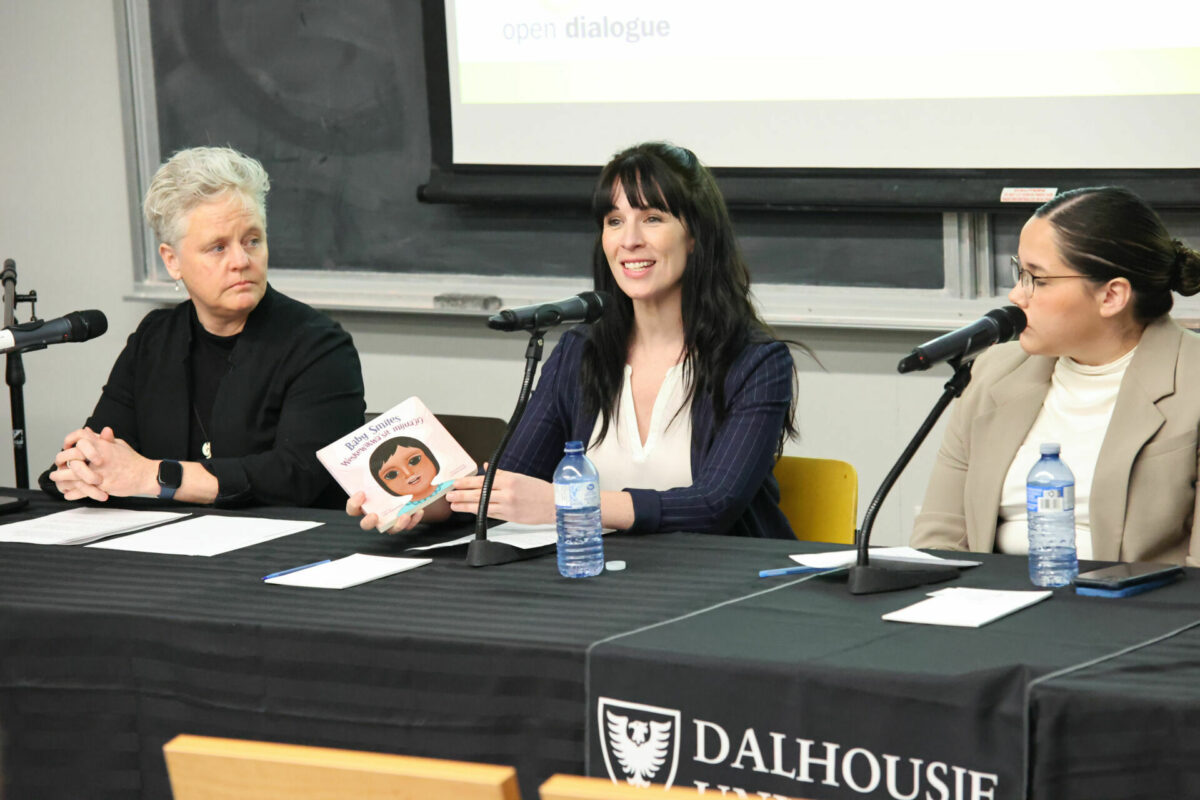Open Dialogue Live: Innovative solutions to improve pediatric health
February 28, 2024
Addressing the social determinants of health, removing barriers to accessing primary care and honouring the rights of children with disabilities are critical steps to improving pediatric health in Atlantic Canada, say a panel of Dalhousie University and community experts.
More than 30,000 children in Nova Scotia alone lack a family doctor or nurse practitioner, Dr. Brenda Merritt, the Dean of Dalhousie’s Faculty of Health, told an Open Dialogue Live audience in Theatre C at the Charles Tupper building on February 21. Another 236 people watched online.
Ensuring those children gain access to primary care is only one change of many required to improve the overall health and well-being of children in the region, four expert panelists said.
“Families from under-represented and under-served communities from across the Maritimes often do not achieve the same health outcomes as others because they may not have the same resources or access to care,” Merritt said.
Pediatric care directly affects adult health outcomes, whether that care relates to physical, mental, or oral health challenges.
“We have one in seven kids in Nova Scotia who are living absolutely below the poverty line,” said Dr. Andrew Lynk, Chief of Pediatrics at the IWK Health Centre and department chair at Dalhousie University. “What are their trajectories like?”
Lynk is among those pushing for a Child and Youth Advocate in Nova Scotia to make sure children’s issues remain at the forefront of public policy responses, he said. He also urged the province to institute a universal breakfast and lunch program in schools. On Feb. 29, Nova Scotia announced a universal lunch program in public schools that will ramp up over four years.
“We have to make these early investments for the next generation coming up,” he said.
One of the other investments Lynk wants Dalhousie to make is to train more pediatricians, including more First Nations’ and African-Canadian pediatricians. The university is planning to increase its pediatric training spots, he says.
Although much of the region’s health planning concentrates on meeting physical and mental health needs, oral health is also critical and often over-looked, said Dr. Shauna Hachey, associate professor in Dental Hygiene and Dentistry.
“While dental decay is generally preventable, it remains the most chronic disease among children across Canada and is the leading cause of day surgery under general anesthesia,” she said.
Indigenous children, children in less affluent communities and children in rural areas are more prone to dental decay and have more difficulty accessing care than their peers, she said.
In Atlantic Canada, dental conditions are among the top three reasons for pain diagnosis among children and youth and are significantly more likely among First Nations’ children and youth, Hachey said.
The result is children living with pain and infection resulting from severe decay, which can affect a child’s ability to eat, sleep, talk learn, play, socialize, result in time missed from school.
To promote the importance of good oral health, Hachey worked with the Tui’kn Partnership, a health partnership among Cape Breton’s five First Nations, to create Baby Smiles. The children’s book is available in Mi’kmaw as a resource for parents and caregivers in Nova Scotia’s First Nations communities, and may be translated to other languages.
Hachey wants more community-based and school oral health programs, as well as greater access to fluoridation and the addition of oral health to well-baby checks.
Although the province funds basic dental care for children 14 and younger, just under a third of eligible children access care.
Part of the issue with accessing oral care for First Nations’ families is the administrative and often up-front cost burden they incur with the federal Non-Insured Health Benefit Program, said Karlee Francis, health director of the Eskasoni Health Centre. Many health providers require families to pay for dental care and sometimes drugs, and then submit receipts to the program to get reimbursed.
“They are having to pay up front when that service is covered, just depending on the practice they go to. That’s a big issue in our community,” Francis said.
Having more Indigenous healthcare providers and non-Indigenous providers who are culturally competent and understand the legacy of colonialism and residential schools is also vital for children’s care, she added.
Another important aspect of improving health for children and youth in Nova Scotia who live with disabilities is more physical activity. There are too-few programs available, and many schools still send children who could participate in adapted activities to the library instead of the gym, says Dr. Sarah Moore, an assistant professor at the School of Health and Human Performance in the Faculty of Health.
Canada is a signatory to the United Nations Convention on the Rights of the Child, and the right to play is one of the Convention’s articles, Moore points out.
Yet “90 per cent of these kids are not getting enough physical activity,” she said.
“When kids are able to engage in play and physical activity early on, they have better cardiovascular health, musculoskeletal health, better social connectedness, and better mental health,” she said.
“We really need to go back to protecting the rights of the child and children with disabilities. We need to do a much better job of fulfilling our obligation to these kids and their families.”

TAGS
